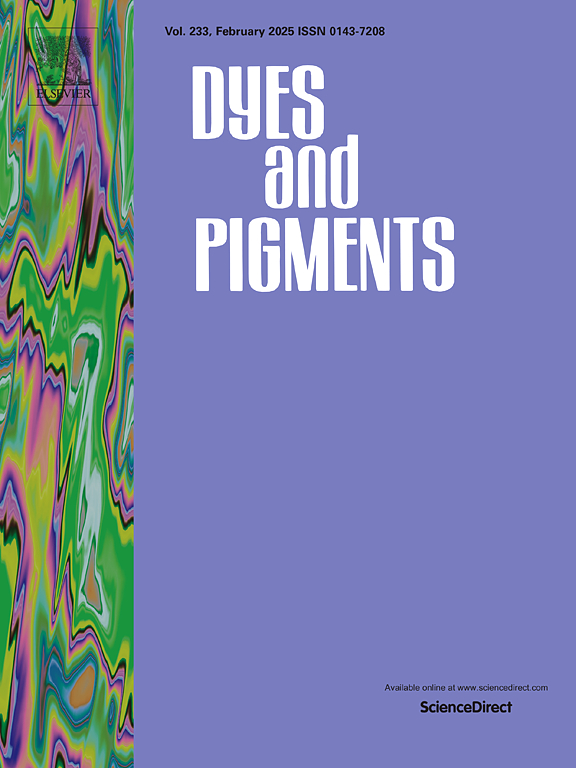A comparative study of aggregation-induced emission in ethynyl-bridged and non-bridged AIEgens derived from tetraphenylethene and naphthalimide
IF 4.2
3区 工程技术
Q2 CHEMISTRY, APPLIED
引用次数: 0
Abstract
Designing efficient organic luminophores with strong emission in the aggregated state remains a challenge due to the common problem of aggregation-caused quenching (ACQ). In this study, we present a comparative analysis of two naphthalimide and triphenylethylene (TPE) derivatives, one featuring an ethynyl (-C ![]() C-) linker between the two (N1N2) and the other directly coupled (NTPE). The introduction of a rigid ethynyl spacer was aimed at minimizing non-radiative decay through restricted intramolecular motions and at suppressing π–π stacking, thereby promoting aggregation-induced emission (AIE) behavior. The AIE characteristics of synthesized scaffolds were confirmed by increased emission intensity and quantum yield in DMSO–water, THF–water mixtures, with aggregation further supported by dynamic light scattering (DLS), HRTEM, and crystal packing data. With rising water content, both particle size and quantum yield also improved, signifying the interrelation between aggregation and emission enhancement. This work emphasizes the role of linker engineering in tuning AIE properties and provides useful insights into how structural variations influence aggregation behaviour and emission efficiency in AIE-active fluorophores.
C-) linker between the two (N1N2) and the other directly coupled (NTPE). The introduction of a rigid ethynyl spacer was aimed at minimizing non-radiative decay through restricted intramolecular motions and at suppressing π–π stacking, thereby promoting aggregation-induced emission (AIE) behavior. The AIE characteristics of synthesized scaffolds were confirmed by increased emission intensity and quantum yield in DMSO–water, THF–water mixtures, with aggregation further supported by dynamic light scattering (DLS), HRTEM, and crystal packing data. With rising water content, both particle size and quantum yield also improved, signifying the interrelation between aggregation and emission enhancement. This work emphasizes the role of linker engineering in tuning AIE properties and provides useful insights into how structural variations influence aggregation behaviour and emission efficiency in AIE-active fluorophores.

由四苯乙烯和萘酰亚胺衍生的乙基桥接和非桥接aigens聚集诱导发射的比较研究
由于聚集致猝灭(ACQ)的普遍问题,设计在聚集态下具有强发射的高效有机发光团一直是一个挑战。在这项研究中,我们对两种萘酰亚胺和三苯乙烯(TPE)衍生物进行了比较分析,一种是在两者之间有乙基(-C -)连接体(N1N2),另一种是直接偶联的(NTPE)。引入刚性乙基间隔层的目的是通过限制分子内运动来减少非辐射衰变,并抑制π -π堆积,从而促进聚集诱导发射(AIE)行为。通过dmso -水、thf -水混合物中发射强度和量子产率的增加证实了合成支架的AIE特性,动态光散射(DLS)、HRTEM和晶体堆积数据进一步支持了其聚集性。随着水含量的增加,颗粒大小和量子产率也有所提高,表明聚集与发射增强之间存在相互关系。这项工作强调了连接器工程在调整AIE特性中的作用,并为结构变化如何影响AIE活性荧光团的聚集行为和发射效率提供了有用的见解。
本文章由计算机程序翻译,如有差异,请以英文原文为准。
求助全文
约1分钟内获得全文
求助全文
来源期刊

Dyes and Pigments
工程技术-材料科学:纺织
CiteScore
8.20
自引率
13.30%
发文量
933
审稿时长
33 days
期刊介绍:
Dyes and Pigments covers the scientific and technical aspects of the chemistry and physics of dyes, pigments and their intermediates. Emphasis is placed on the properties of the colouring matters themselves rather than on their applications or the system in which they may be applied.
Thus the journal accepts research and review papers on the synthesis of dyes, pigments and intermediates, their physical or chemical properties, e.g. spectroscopic, surface, solution or solid state characteristics, the physical aspects of their preparation, e.g. precipitation, nucleation and growth, crystal formation, liquid crystalline characteristics, their photochemical, ecological or biological properties and the relationship between colour and chemical constitution. However, papers are considered which deal with the more fundamental aspects of colourant application and of the interactions of colourants with substrates or media.
The journal will interest a wide variety of workers in a range of disciplines whose work involves dyes, pigments and their intermediates, and provides a platform for investigators with common interests but diverse fields of activity such as cosmetics, reprographics, dye and pigment synthesis, medical research, polymers, etc.
 求助内容:
求助内容: 应助结果提醒方式:
应助结果提醒方式:


